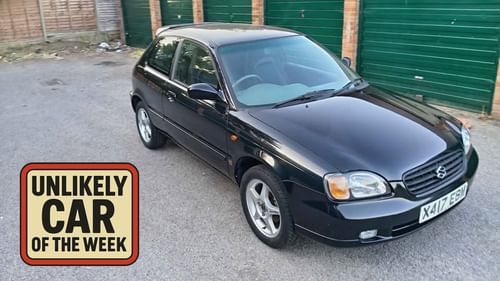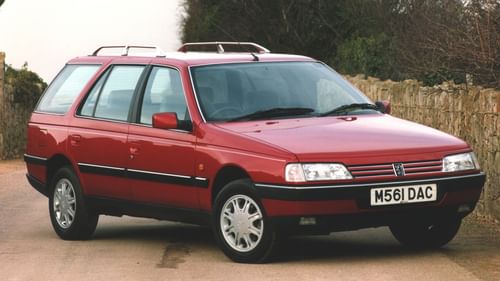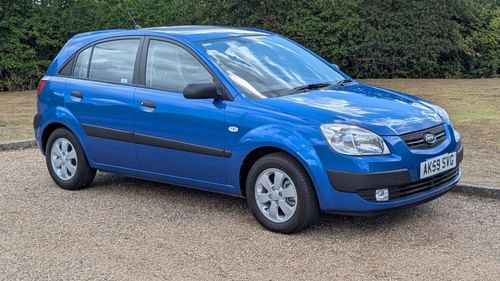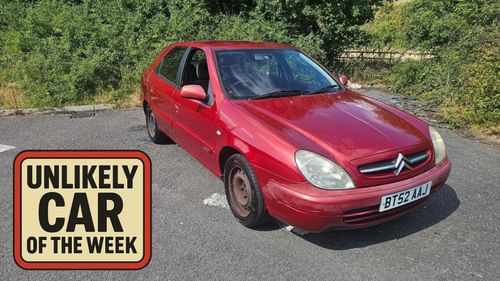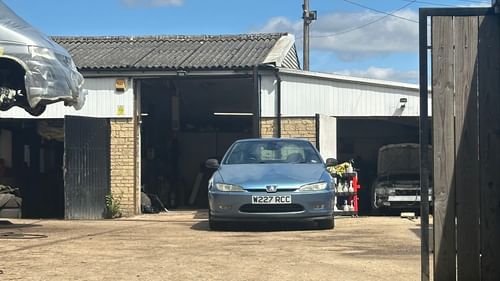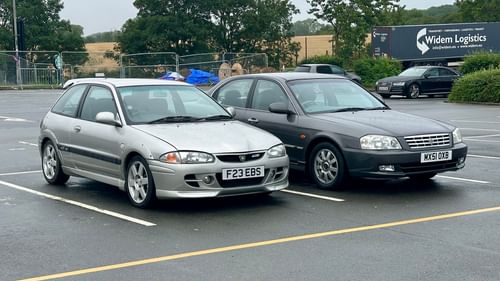
I’ve always enjoyed crossing the River Severn. Be it over the original Severn Bridge or the Second Severn Crossing, hopping from England to Wales has invariably signalled the start of a holiday or the promise of a good drive on one of Britain’s best roads. Something positive. An event to look forward to. But to borrow a line from Bob Dylan, famously photographed waiting for a ferry to cross the Severn, the times they are a-changin’. Driving in Wales today can be a frustrating experience.
Things were different in March 2004, when this Skoda Octavia vRS was delivered to its first owner. An age before 50mph limits on the M4, average speed cameras on some of the best driving roads, and 20mph zones in built-up areas. The pace of change at Skoda was a little more… um, rapid than making progress through the principality. It was thirteen years since Volkswagen had bought the company, but just four years had passed since it increased its stake to 100 percent. The Felicia, launched in 1994, was the first car to benefit from Volkswagen’s input, but the Octavia was a quantum leap forward for the brand. Released in the Czech Republic in 1996, it arrived in the UK in 1998, before being joined by the Fabia supermini.
Anyone under the age of 30 will find it hard to believe, but back then, Skoda was seriously uncool. An entire generation had grown up listening to terribly unfunny jokes at Skoda’s expense. How do you double the price of a Skoda? Fill the tank. What do you call a Skoda with a sunroof? A skip. Why does a Skoda have a heated rear window? To keep your hands warm when you’re pushing it. Guffaw, etc, etc.
Skoda used this negative image to its advantage. The ‘It’s a Skoda. Honest’ ad campaign was credited with transforming the brand’s reputation, helping the company to achieve a record 35,000 sales in 2001. The repositioning coincided with the launch of the Fabia and reduced marque rejection from 60 percent to 40 percent. The ‘Honest’ campaign was followed by a series of adverts with the endline of ‘It’s a Skoda. Which for some is still a problem.’ Brilliant. A self-deprecating and honest approach that tackled the brand’s biggest problem head-on. Fine, if you’re hoping to attract the kind of buyer who favours rationality over emotion but appealing to car enthusiasts would be a tougher challenge. Victory wouldn’t be easy.
Which is where the ‘victory Rally Sport’ (vRS) badge comes in. The name harks back to Skoda's rally cars of the 1970s: the rear-engined 180 and 200 RS coupés, and most notably the 130 RS of 1975, Skoda's first ever works rally car and class winner at the 1977 Monte Carlo Rally. Instant heritage and credibility for a hot hatch of the new millennium, but while the rest of the world would call it the Octavia RS, it would be known as the vRS in the UK. Contrary to popular belief, Ford didn’t take Skoda to court to prevent the use of the fabled RS name. A spokesperson for Skoda UK told us there was no RS-kicking, saying: ‘Like many urban myths, the notion of Ford threatening action may add to the story but to our knowledge it isn’t true. Ford has historical links to the RS badge in the UK, so we wanted to build a sub-brand of our own here, which is why it became vRS.’ This didn’t prevent early road tests referring to the car as the Octavia RS, but the vRS name stuck, helped in no small part by the arrival of the Fabia vRS diesel hot hatch, which attracted mainstream attention thanks to its giant-killing capabilities.

The Octavia vRS, built to celebrate Skoda's centenary in motor sport and return to the WRC, arrived in 2001. Though it was often said that it was a budget Golf GTI with a cavernous boot, it enjoyed some early bragging rights over its illustrious counterpart thanks to its 1781cc 20-valve turbocharged engine. While the Mk4 Golf GTI 1.8 had to make do with 148bhp until the arrival of the 25th Anniversary in 2002, the Octavia’s 177bhp at 5500rpm placed it alongside the entry-level Audi TT and SEAT Leon Cupra. Officially, the vRS could hotfoot to 62mph in 7.9 seconds before hitting a top speed of 146mph, although Autocar claimed it could complete the sprint in 6.7 seconds. A case of Skoda being typically conservative with its figures or had the press cars been tweaked? Whatever, £15,100 (about £27,000 in today’s money) undercut all but the three-door Golf GTI with the 1984cc 8-valve engine, which was about as hot as a korma. The Octavia vRS wasn’t quite a vindaloo but could pass as a bhuna on the curry scale. The ingredients included stiffer springs, uprated dampers, thicker anti-roll bars, a 15mm drop in ride height, 312mm ventilated discs at the front, 256mm solid discs at the back, green brake calipers, 17-inch alloys, Pirelli P-Zero tyres and a dash of chilli powder.
The visual makeover was subtle but effective: deep front bumper, rear spoiler, hexagonal chrome-tipped exhaust pipe and… that’s it. Four colours were available: Black Magic Pearl, Lemon Yellow, Corrida Red and Diamond Silver Metallic. Inside, the vRS featured leather seats with metallic mesh cloth panels, leather gear knob with vRS emblem, stainless steel pedals and rally-inspired dials. The specification wasn’t lavish – for that you needed the Elegance or Laurin & Klement models – but it offered everything a hot hatch buyer needed, except the right badge. Cultivating the right image would take time, but there’s no doubt that the Octavia vRS played a small but significant role in Skoda’s march from obscurity to mainstream acceptability.
For me, this was like travelling back in time; I had a thing for the Octavia vRS from the moment it arrived in UK showrooms. I remember taking my friend to a Skoda dealer in Bournemouth and telling him, in a style not too dissimilar to Wayne Campbell, that it would be mine. Oh yes, it would be mine. I just loved the look of it, particularly in profile, and viewed the Skoda badge as a positive, rather than a negative. A working-class hero with green calipers. I fancied a yellow one, but concerns that I would be mistaken for a Bournemouth taxi put paid to that crazy idea. Instead, I ended up with a red one, just like Skoda UK’s immaculate example I took to Wales. It was the first and only time I’ve driven away from a car dealer with £7000 cash in my hand, having traded in my VX220 Turbo for a £10,000 Octavia vRS. Believe it or not, there was a time when I owned some properly good cars and wasn’t hopelessly in love with French tat. But that’s a story for another day.
Weighty flip key in my hand, I unlock the car at 6am and watch the chrome door pins pop up from the top of the door cards. I always thought that was a neat touch. Climbing inside, I’m taken back to a time when I had more hair, more disposal income and dreams of making it big in the creative industry. The car is smaller than I remember, but then trading in a snug VX220 for a spacious Octavia was like moving out of a bedsit and into a warehouse. It’s all so simple: a pair of traditional dials behind a steering wheel blissfully free of audio or climate controls, radio/cassette with a push-out knob/dial for the volume, gear knob showing five cogs plus reverse, and a basic Climatronic unit for heating and ventilation. The mesh-effect door cards and centre console cladding haven’t aged as well as the exterior styling, but everything is of its time.

More memories come flooding back after I’ve tackled the rural roads of Devon and have joined the A30 dual carriageway. Back in the day, several police forces deployed the Octavia vRS, either marked or unmarked, so I’d often see drivers slow down as they approached from behind, just to check there wasn’t a traffic cop at the wheel. I should have put a high-vis jacket on the back shelf…
The tedium of the M5 sis punctured only by a typically good flat white from McDonald’s, which cools down while sitting in the single pop-up cupholder between the front seats. This ages the car as much as anything else, although I should point out that my 1997 Toyota Camry has no fewer than four good-size cupholders. That said, the Camry doesn’t handle corners particularly well and wouldn’t look good with a set of green calipers. Czechmate.
Exiting the M5 at the end of the Avonmouth Bridge and onto the M49 – which opened in 1996, making it as old as the Mk1 Octavia – feels like a shortcut on a racing game. An opportunity to bypass the variable speed limits alongside Cribbs Causeway and avoid the horror of the Almondsbury Interchange. It’s also notable for being the only motorway that doesn’t touch the ordinary road network and, for now, the only one without junctions. This is the kind of nonsense that occupies my mind once the caffeine has worn off and I’ve run out of podcasts to listen to. Never mind, very soon I’ll have the wonderful Welsh roads to stop my mind from wandering…
The landscape changes on the Prince of Wales Bridge. To the left, the huge expanse of the Severn Estuary, flanked by England on the left and Wales on the right. To the right, the majesty of the original Severn Bridge, one of Britain’s finest feats of engineering. To the front, traffic. Lots of it. The 60 miles to my junction north of Swansea is a frustrating mix of 50mph zones, congestion and stop-start traffic, every junction marked by a tailback extending on to the motorway. A yellow sign warns that ‘POLLUTED AIR KILLS SLOW DOWN’ as I drive by at a steady 25mph in my 192g/km-of-CO2 hot hatch. How long until ‘dinosaurs’ like this vRS are banned from entering Wales? My tinge of guilt turns to mild amusement as I notice a sign saying ‘SPEED LIMIT IN FORCE TO IMPROVE AIR QUALITY’ as I crawl past the clouds hanging over the Port Talbot steelworks.

Tedium gives way to tiredness as I exit the M4 and begin the final stretch to my rendezvous with Simon the photographer on the Black Mountain Pass. It’s another 20 minutes of playing bingo with 20mph, 30mph, 40mph and 50mph speed limits before I see the first ‘Grandma’s getting frisky’ sign since leaving a sleepy Devon three hours earlier. A mile later, I’m doing 40mph again and wondering if I should have stayed in bed. To make matters worse, I appear to be in a dead zone for coffee shops, which is far from ideal when you’re about to spend six hours in a remote part of the Welsh countryside. Fortunately, the Black Mountain Centre Café is open and is highly recommended if you’re after desperate for a decent mug of caffeine.
The Octavia has swallowed the journey with ease. It may have 72,000 miles on the clock, but it feels as fresh as the 10,000-mile car I owned in 2005. Being in the care of Skoda UK helps, but it’s a car you could use every day. Despite the lowered ride height, stiffer springs, firmer dampers and large (for their time) tyres, the Octavia rides beautifully over all but the worst imperfections. You won’t spend your entire time scanning the road for potholes and drain covers, which is handy when you’re busy trying to work out the prevailing speed limit…
Not that you’ll be in any doubt on the famous Black Mountain Pass, which rises out of Brynamman to snake through the western fringes of the Brecon Beacons National Park, now known as Bannau Brycheiniog. It’s part of the 20-mile A4069, which concludes at a junction with the A40 in Llandovery and is widely considered to be one of the best driving roads in the country. At least it was, until the speed limit was reduced to 40mph. Worse still, in March 2023, five average speed cameras were installed on the route by the Wales road safety partnership GoSafe and Carmarthenshire Council. Whatever your views on the merits (or otherwise) of speed cameras, the five yellow and white poles and supporting road signs are a serious blot on the scenery. Like littering a ‘Capability’ Brown landscape with garden gnomes or slapping a vinyl roof on a Lamborghini Miura.
It means that I’m unable to stretch the Octavia’s legs. But I can’t help myself. Once clear of the first camera, I change down to second, hit the throttle and revel in the acceleration. It’s quick, even by today’s standards, but I’d forgotten about the shove. Thanks to the wide torque band – peak torque is 173lb ft at 1950-5000rpm – it pulls smoothly and strongly in every gear, even if the four-pot is as characterless as I remember. The 40mph limit means there’s no need to change out of second, although in theory you could tackle the entire pass in first. There aren’t as many laybys as I remember – have they been removed to prevent riders and drivers from stopping to lower their average speed – but I stop to take in the view and avoid an unwanted letter from the local authority.

For the next few hours, I’m either waiting in the cold for Simon to sort the statics or perfecting my road test face as he shoots the car in motion. I’m having fun. Away from the glare of the speed cameras, which are conveniently located some distance from the road’s most famous hairpin bend, I’m enjoying the snappy gearchange, flat cornering and eager acceleration. The brakes are good, so I have the confidence to enter bends at a fair lick, and the grip and absence of torque steer makes it easy to exit again, especially with the ASR (Anti-Slip Regulation) switched off. Two decades of vRS excellence may have removed the surprise factor from Skodas with a performance edge, but when this car was new, it was like your accountant phoning you to say that he was giving up figures to become a megavalanche bike racer. It had no right to be this good, especially when you consider it shared a lot in common the lacklustre Golf GTI. The Mk4 only felt good in V5 and R32 guises, but the Octavia vRS was great, straight out of the box.
With shooting over, I tell Simon that I’m going to set the sat-nav to avoid motorways until I reach the Severn. A chance to enjoy the car at higher speeds on the roads across the Beacons formerly known as Brecon. Big mistake. It’s only 3pm, but as soon as I’m back in civilisation, I’m thrust into what feels like an endless traffic jam to Chepstow. In the age of 20mph zones, does everyone in Wales leave work two hours early to make sure they make it home before their children’s bedtime? Did I catch Wales on a bad day? Every junction, every roundabout and every slip road is blighted by nose-to-tail traffic. I’m followed through a lengthy 20mph zone by a chap in an MG3. He’s keeping to the limit while having a phone pressed up to his right ear and a child in the passenger seat with their feet on the dashboard. His ability to change gear and steer with one hand is admirable, but it exposes the folly of roads policed by cameras and the mistaken belief that 20mph zones will make everything better. I won’t bore you with the details – I’ve waffled on for too long – but I finally crossed the old Severn Bridge at 6pm, some three hours since leaving the viewpoint on the A4069. I’ve never been happier to see the ‘Welcome to England’ sign. I’m not saying that Wales is more anti-car than Switzerland, but I reckon the glory days are over.
I have the most fun on the derestricted roads that link my house with the A30. Like most hot hatches, the Octavia vRS is based on humble underpinnings, but it nails the ‘humdrum to hero’ transformation with aplomb. Despite the massive snail house at the rear, it feels small by today’s standards, and although the steering offers little in the way of feedback, the thin-rimmed wheel feels good in your hands. The transition from motorway loafer to B-road livewire is seamless, so when I get home, I’m thinking about doing it all again tomorrow. Which I do, but not in Wales.
The Octavia vRS won’t be remembered as one of the all-time great hot hatches; it lacks the precision and eagerness of, say, the Honda Accord Type-R or Ford Focus ST170. And that’s fine because it’s one of the most well-rounded performance hatches I have driven. Just enough performance to entertain, a well sorted chassis that suggests the Mk4 Golf GTI should have been better, comfortable, good-looking, relatively obscure, and practical, even if some boot space could have been sacrificed to free up some legroom for rear-seat passengers. It represented terrific value when new and remains a bargain in 2024. A victory for common sense.
This article first appeared in issue 26 of Classic.Retro.Modern. magazine.
